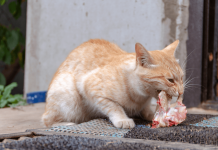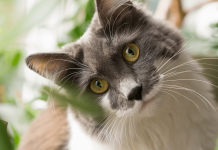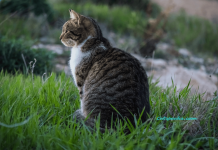Cats will chew on the leaves of your indoor or outdoor plants. They do it out of curiosity and boredom. Do you know tasting the leaves and flowers can turn into a horrific incident if the plant is toxic? According to statistics of a renowned veterinary center, almost one-third of their total phone call was logged due to the feline ingestion of poisonous plants.
This is a true crisis and as a cat parent, you should know which plants should be out of your feline’s range. You will be surprised to know that the very common flowers like Tulip or lily will make it to the list.
Let’s find out the poisonous plants to cats and their effects.
What Plants Are Poisonous To Cats?
If we start counting all the flowers and plants that harm our felines, you will be surprised to see the numbers. Also, it will be hard for you to remember all those plants. Here I will only add those plants or flowers that are common to us and accessible to the felines.

1. Azaleas and Rhododendrons
Mostly cats and dogs are poisonous to Azaleas. The rhododendrons are relative to the azaleas. Both these plants are considered moderately poisonous according to the experts. The felines will probably consume these flowering bushes by watching the beauty and scent. But then the side effect is mandatory. Here are the visible effects of ingesting azaleas and rhododendrons:
- Vomiting
- Excessive drooling
- Fatigue
- Imbalance walk
- Loss of appetite
- Weakness
- Upset tummy
- Seizures
- Coma
2. Cyclamen
Persian violet or sowbread, no matter by which name you call it, the cyclamen are common indoor plants poisonous to cats. Though the whole plant is toxic to the cats, the tuber and roots contain most of the poisonous content. Even a small quantity of consumption of these plants will make the feline sick. Here are the signs of cyclamen toxicity:
- Vomit
- Drooling
- Diarrhea
- Seizures
- Abnormal heart rate
- Death
Read Also: How To Keep Cats Out Of Plants? Stop Cats to Eating Plants
3. Sago Palm
A few types of sago palms are kept as indoor plants. Mostly, these plants are found outside. People also know these plants as cardboard palm, coconut palm, zamias, or cycads. The sago palm is incredibly poisonous, especially the seeds of this plant are the deadliest. If your cat chews the leaves or any other part of this plant, then it is in danger.
Here are the visible effects of sago palm toxicity in cats:
- Lethargy
- Vomiting
- Diarrhea
- Bruising
- Black stool
- Liver failure
- Increased thirst for water
- Death
The experts claim that only 50% of cats survive from this sago palm toxicity.
4. Mistletoe
The mistletoe is one of the severely toxic plants that can affect your pet feline. In case, the cat ingested a large quantity of mistletoe, the pet might fall into death. Other effects are:
- Vomiting
- Diarrhea
- Breathing difficulty
- Seizure
- Low heart rate
- Temperature drop
- Coma
- Staggering
- Excessive thirst
- Low blood pressure
- Digestive irritation
5. Autumn Crocus
Autumn crocus or you may know this flowering plant as naked lady and meadow saffron. This flower is highly poisonous to cats due to the alkaloid colchicine content. Ingestion of this plant will have the following effects on kitties:
- Kidney damage
- Respiratory failure
- Breathing difficulty
- Drooling
- Bloody diarrhea
- Vomiting
- Liver damage
- Seizure
- Death
6. Ivy
While there are safe ivy plants like grape ivy and coliseum ivy, some other ivy plants are poisonous to pets. Consuming the leaves will make the cat drool and vomit. Also, the feline will suffer from muscle weakness, fever, breathing difficulties, and diarrhea.
7. Narcissus
Narcissus is a common plant in our garden. This plant goes by the name of the paperwhite or jonquil. Daffodil also enters the group when you talk about the toxicity of this plant. Though the whole plant is poisonous, the bulbs are considered the deadliest part of it. The cats will suffer due to the lycorine content of the plant.
Here are the toxicity symptoms of the narcissus plant:
- Low blood pressure
- Cardiac arrhythmia
- Convulsion
- Breathing difficulty
- Abdominal pain
8. Oleander
You will find the oleander plants in most gardens because they enhance the beauty of the yard. But if you have cats, dogs, or other pets in your house, you may think twice before planting oleander in your garden. Even a small amount of oleander plant can kill your cat. The fruits, flowers, leaves, roots, everything of this plant is toxic.
If your cat ingests oleander, it will suffer from the following conditions:
- Digestive problems
- Upset tummy
- Vomiting
- Depression
- Irregular heart rate
- Breathing difficulty
- Death
9. Dieffenbachia
The Dieffenbachia tropical flower goes around various names. You can call it dumb cane, charming dieffenbachia, or giant dumbcane. It is a common decoration in our home and offices. This plant is rich in insoluble calcium oxalate crystal. This component can cause irritation in your feline’s mouth and stomach. Besides, the pet will drool, vomit, and in worse cases, it will have difficulty in swallowing food.
10. Lily
Who does not love lily? It is beautiful and enhances the beauty of any decoration. If you have cats or dogs, then you must not bring lilies in your home. Scientists claim that lilies are the most dangerous plant for cats. Even a little ingestion may cause death to the pet. If your feline drinks water from the vase of lilies, it will develop kidney or liver damage in no time. This is how dangerous this flower is for cats.
11. Most Toxic Plants for Cats
I have mentioned 10 plants that trouble your feline. Of course, there are many more. Here is a list that may help you:
- Tulip
- Hyacinths
- Kalanchoe
- Aloe
- Adam and Eve
- Peony
- Hydrangea shrubs
- Arum
- Pie plant
- Holly shrubs
- Euphorbia plants
- Ficus
- Snake plant
- Golden pothos

If a cat accidentally consumes any part of a poisonous plant, it will drool, vomit, suffer from diarrhea, have difficulty breathing, and become lazy. You need to pick up the signals and take the pet to a vet. Without immediate action, the cat might die. Also, make sure your garden or indoor does not have any plants toxic to the pets.
Read More: What Human Foods Can Cats Eat? And What Human Foods Can Cats Not Eat?






































